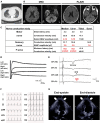Case Report: Takotsubo Cardiomyopathy in Bickerstaff Brainstem Encephalitis Triggered by COVID-19
- PMID: 35002947
- PMCID: PMC8741194
- DOI: 10.3389/fneur.2021.822247
Case Report: Takotsubo Cardiomyopathy in Bickerstaff Brainstem Encephalitis Triggered by COVID-19
Abstract
Takotsubo cardiomyopathy (TCM) is a stress-induced cardiomyopathy triggered by critical illness including severe neurological disorders. However, an association between TCM and Bickerstaff brainstem encephalitis (BBE) has rarely been described. During the current coronavirus disease 2019 (COVID-19) pandemic, growing evidence indicates that COVID-19 often leads to various neurological disorders, but there are few reports of an association between COVID-19 and BBE. Here we report a case of TCM associated with BBE triggered by COVID-19, which subsided with immunotherapy for BBE. Both transthoracic echocardiography and electrocardiography led to early and accurate diagnosis of TCM. Sustained hemodynamic instability due to TCM was immediately lessened with immunotherapy whereas additional plasmapheresis and immunotherapy were required to treat BBE. This case indicates that BBE might follow COVID-19 and TCM should be considered when hemodynamic status remains unstable in a patient with BBE.
Keywords: Bickerstaff brainstem encephalitis; Takotsubo cardiomyopathy; anti-GQ1b ganglioside antibody; coronavirus disease 2019; hemodynamic instability; intravenous immunoglobulin therapy; transthoracic echocardiogram.
Copyright © 2021 Kimura, Hashiguchi, Tanaka, Hagiwara, Takahashi, Miyaji, Joki, Doi, Koga, Takeuchi and Tanaka.
Conflict of interest statement
HT is an Associate Editor of Frontiers in Neurology and Frontiers in Immunology. The remaining authors declare that the research was conducted in the absence of any commercial or financial relationships that could be construed as a potential conflict of interest.
Figures


Similar articles
-
[Clinical features of 19 children with Bickerstaff brainstem encephalitis].Zhonghua Er Ke Za Zhi. 2019 May 2;57(5):363-367. doi: 10.3760/cma.j.issn.0578-1310.2019.05.009. Zhonghua Er Ke Za Zhi. 2019. PMID: 31060129 Chinese.
-
Anti-ganglioside complex antibody profiles in a recurrent complicated case of GQ1b-seronegative miller fisher syndrome and Bickerstaff brainstem encephalitis: a case report.BMC Neurol. 2018 May 23;18(1):72. doi: 10.1186/s12883-018-1077-5. BMC Neurol. 2018. PMID: 29792178 Free PMC article.
-
Case report: A pediatric case of Bickerstaff brainstem encephalitis after COVID-19 vaccination and Mycoplasma pneumoniae infection: Looking for the culprit.Front Immunol. 2022 Aug 12;13:987968. doi: 10.3389/fimmu.2022.987968. eCollection 2022. Front Immunol. 2022. PMID: 36032138 Free PMC article.
-
Bickerstaff Brainstem Encephalitis and overlapping Guillain-Barré syndrome in children: Report of two cases and review of the literature.Eur J Paediatr Neurol. 2019 Jan;23(1):43-52. doi: 10.1016/j.ejpn.2018.11.008. Epub 2018 Nov 20. Eur J Paediatr Neurol. 2019. PMID: 30502045 Review.
-
Bickerstaff encephalitis in childhood: a review of 74 cases in the literature from 1951 to today.Front Neurol. 2024 Mar 12;15:1387505. doi: 10.3389/fneur.2024.1387505. eCollection 2024. Front Neurol. 2024. PMID: 38533411 Free PMC article. Review.
Cited by
-
First case report on Bickerstaff brainstem encephalitis in a young adult from Syria: Bridging clinical knowledge and practice.Radiol Case Rep. 2024 Dec 3;20(2):1211-1214. doi: 10.1016/j.radcr.2024.11.006. eCollection 2025 Feb. Radiol Case Rep. 2024. PMID: 39697258 Free PMC article.
-
Takotsubo syndrome and COVID-19: A systematic review.Health Sci Rep. 2022 Dec 2;6(1):e972. doi: 10.1002/hsr2.972. eCollection 2023 Jan. Health Sci Rep. 2022. PMID: 36479387 Free PMC article.
-
Encephalitis in Patients with COVID-19: A Systematic Evidence-Based Analysis.Cells. 2022 Aug 18;11(16):2575. doi: 10.3390/cells11162575. Cells. 2022. PMID: 36010650 Free PMC article.
-
Bickerstaff brainstem encephalitis developed quickly after COVID-19 infection.Acute Med Surg. 2025 Jul 2;12(1):e70071. doi: 10.1002/ams2.70071. eCollection 2025 Jan-Dec. Acute Med Surg. 2025. PMID: 40606543 Free PMC article.
References
Publication types
LinkOut - more resources
Full Text Sources

